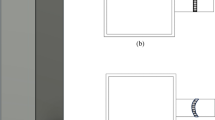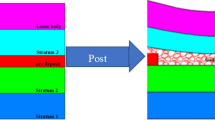Abstract
Mining is a major industry worldwide, where hydraulic fills are commonly used for backfilling the underground voids created in the ore removal process. Hydraulic fills placed in the form of slurry drain through free draining barricades that block the access drives during the filling process. Failure of the barricades, followed by the in-rush of tailings into the mine can be catastrophic. This paper describes a simple method based on three-dimensional method of fragments, for computing the flow rates. Laboratory tests were carried out on model stopes filled with sands, and the measured flow rates compared well with those computed using the proposed method. This was also verified through numerical modelling. The proposed expressions for computing the flow rate in the three-dimensional hydraulic fill stope can be useful in the development of a spreadsheet-based fill simulation program that will help in monitoring the water level and flow rate within the stope, and improve mine safety.




Similar content being viewed by others
References
Berndt CC, Rankine KJ, Sivakugan N (2007) Material properties of barricade bricks for mining applications. Geotech Geological Eng Springer 25(4):449–471
Isaacs LT, Carter JP (1983) Theoretical study of pore water pressures developed in hydraulic fill in mine stopes. Transact Inst Min Metall Sect A Min Industry 92:A83–A102
Itasca (2002a) FLAC3D. Fast Lagrangian analysis of continua in 3 dimensions—user’s guide, version 2.1. Itasca Consulting group, Minneapolis
Itasca (2002b). FLAC, Fast Lagrangian analysis of continua—user’s guide, version 4.0. Itasca Consulting group, Minneapolis
Kuganathan K (2001a). Design and construction of shotcrete bulkheads with engineered drainage system for mine backfilling. Proceedings of International seminar on surface support liners, Australian Centre of Geomechanics, Perth, Australia. 1–15
Kuganathan K (2001b) Mine backfilling, backfill drainage and bulkhead construction—a safety first approach. Australia’s mining monthly February. 58–64
Li L, Aubertin M (2008) An improved analytical solution to estimate state subvertical backfilled stopes. Can Geotech J 45(10):1487–1496
Li L, Aubertin M (2009) Numerical investigation of the stress state in inclined backfilled stopes. Int J Geomech ASCE 9(2):52–62
Li L, Aubertin M, and Simon R (2003). Modelling arching effects in narrow backfilled stopes with FLAC. Proceedings of 3rd International Symposium on FLAC and FLAC3D Numerical Modelling in Geomechanics, Ontario, Canada, 211-219
Pavlovsky NN (1956) Collected works. Akad Nauk USSR, Leningrad
Rankine KJ (2005). An investigation into the drainage characteristics and behaviour of hydraulically placed mine backfill and permeable minefill barricades. PhD Thesis, James Cook University, Australia
Rankine KJ, Sivakugan N, Cowling (2006) Emplaced geotechnical characteristics of hydraulic fills in a number of Australian mines. Geotech Geological Eng Springer 24(1):1–14
Sivakugan N, Rankine RM, Rankine KJ, Rankine KS (2006) Geotechnical considerations in mine backfilling in Australia. J Cleaner Prod Elsevier 14(12–13):1168–1175
Sivakugan N, Rankine KJ, Rankine R (2006) Permeability of hydraulic fills and barricade bricks. Geotech Geological Eng Springer 24(3):661–673
Sivakugan N, Rankine KJ, Rankine KS (2006) Study of drainage through hydraulic fill stopes using method of fragments. Geotech Geological Eng Springer 24(1):79–89
Sivakugan N, Rankine KS (2012) Three dimensional method of fragments to study drainage through hydraulic fills. Int J Geomech ASCE 12(5):612–615
Ting CH, Shukla SK, Sivakugan N (2011) Arching in soils applied to inclined mine stopes. Int J Geomech 11(1):29–35
Ting CH, Sivakugan N, Read W, Shukla SK (2012) Analytical method to determine vertical stresses within a granular material contained in right vertical prisms. Int J Geomech ASCE 12(1):74–79
Traves WH, Isaacs LT (1991) Three dimensional modelling of fill drainage in mine stopes. Transact Inst Min Metall Sect A Min Industry 100:A66–A72
Acknowledgments
The authors gratefully acknowledge the valuable contributions made by Mr. Warren O’Donnell, the Laboratory Manager of the Geotechnical Laboratory, James Cook University, in the design and fabrication of the laboratory model stope and in carrying out the tests.
Author information
Authors and Affiliations
Corresponding author
Rights and permissions
About this article
Cite this article
Sivakugan, N., Rankine, K., Lovisa, J. et al. Flow Rate Computations in Hydraulic Fill Mine Stopes. Indian Geotech J 43, 195–202 (2013). https://doi.org/10.1007/s40098-013-0043-9
Received:
Accepted:
Published:
Issue Date:
DOI: https://doi.org/10.1007/s40098-013-0043-9




